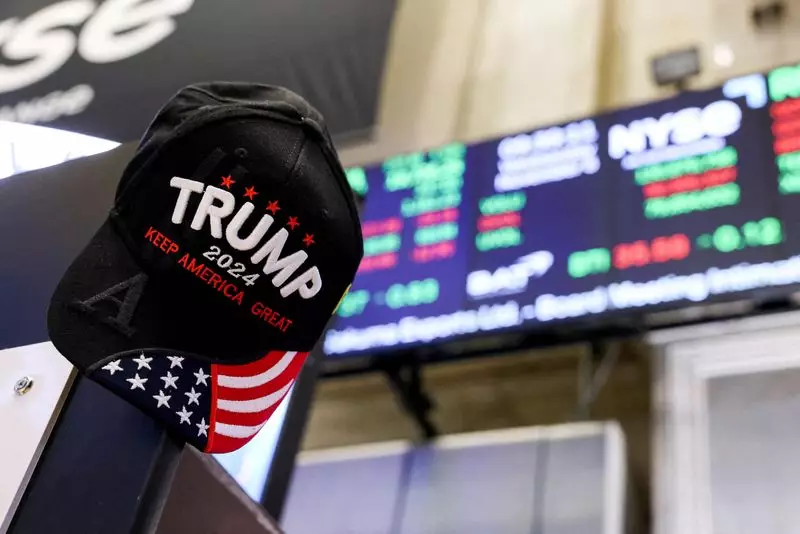Monday’s trading on Wall Street showcased a potpourri of optimism, with all major indexes soaring to impressive gains. Notably, the small-cap Russell 2000 index leapt to an unprecedented high, reflecting a market buoyed by Scott Bessent’s nomination as U.S. Treasury Secretary. This pivotal event was instrumental in driving bond yields downward, a move that generally stimulates buying in equities. Additionally, discussions around a potential ceasefire between Israel and Lebanon contributed to the decline in oil prices, which in turn adversely affected the Energy sector, causing it to dip by 2%.
Investors had been on edge leading up to this nomination, speculating how fiscal policies might unfold under the new administration. By selecting Bessent, President-elect Donald Trump seemed to calm fears regarding rising government borrowing that had permeated market sentiments in recent weeks. Investment strategists are mixed about future developments but view this nomination as a sign that there could be a more measured approach to fiscal policies moving forward.
Scott Bessent’s appointment is not just a mere footnote; it is indicative of how the new administration might prioritize economic management while attempting to fulfill its campaign pledges related to fiscal and trade policies. “This time, focus is on tariff policy – especially now that Bessent’s nomination seems to have allayed major fiscal concerns,” remarked James Reilly, a senior market economist.
The investor community is cautiously optimistic, as reflected in the S&P 500, which climbed by 17.81 points (0.30%) to settle at 5,987.15 points. Similar trends were noticeable in the Nasdaq Composite, up by 51.50 points (0.27%), while the Dow Jones Industrial Average noted a significant jump of 439.02 points (0.99%). Such robust performance underscores the market’s appetite for risk and its readiness to react positively to favorable news.
Advancing stocks outpaced decliners by a substantial 3.01-to-1 ratio on the NYSE, signaling a broad-based rally that influenced 836 stocks to hit new highs against just 40 that reached new lows. The small-cap index alone marked a historical intraday peak of 2,466.49, surpassing levels reached three years prior. Such performance is often a reflection of investor confidence in the economic trajectory, accentuated by falling Treasury yields, particularly that of the 30-year bond, which saw considerable declines.
“There’s a noticeable shift; areas that lagged earlier, such as small-cap and mid-cap stocks, are beginning to thrive,” said Adam Sarhan, CEO of 50 Park Investments. Investor enthusiasm has been sharply aligned with expectations that the Trump administration, supported by a Republican Congress, will enact pro-business policies that may invigorate small-cap stocks.
The decline in yields is particularly advantageous for sectors sensitive to rate fluctuations. Indeed, the Real Estate sector enjoyed a boost, and the Housing index surged by an impressive 4.5%. Analysts are also adjusting forecasts based on prevailing trends, with Barclays increasing its full-year projection for the S&P 500 while Deutsche Bank aims for a lofty target of 7,000 points by 2025.
However, the market is not without its uncertainties, chiefly stemming from inflationary concerns that could temper the Federal Reserve’s accommodative stance. The discussions amongst investors have oscillated between hopes for a pause in interest rate cuts versus predictions of further reductions, further amplified by the FedWatch Tool indicating a 56.2% likelihood of a 25 basis-point cut in the upcoming December meeting.
In particular, Consumer Discretionary sectors showed signs of vitality. Amazon.com gained 2.2%, significantly influencing sector performance. However, not all companies basked in the glow of growth; Macy’s reported a setback, falling 2.2% after delaying third-quarter results attributed to an accounting issue. In contrast, Bath & Body Works shone brightly by bettering its full-year profit forecast, driving shares up by 16.5%.
The trend reported by the S&P 500 listed 106 new 52-week highs without posting any new lows, while the Nasdaq Composite saw 352 new highs juxtaposed with 66 new lows. Overall, trading volumes surged to 16.69 billion shares, outpacing the 14.93 billion average across the last 20 trading days, further corroborating this surge in market activity.
Wall Street is experiencing a vibrant rally, stemming from a convergence of positive political developments, regulatory expectations, and an increasingly optimistic economic outlook, even as concerns regarding inflation linger just below the surface.

